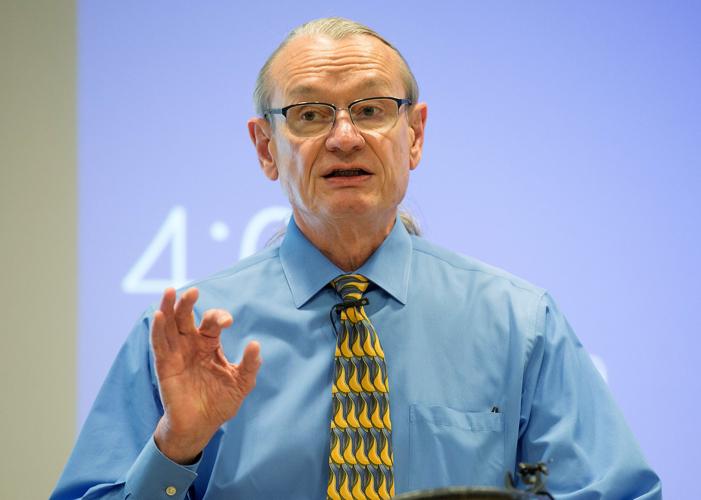With the number of coronavirus cases growing fast here, Pima County health officials maintained they’re reaching out to every COVID-19 patient to potentially identify any outbreak clusters and overcome limited widespread testing.
But that has come with challenges, according to Dr. Bob England, the interim director of the county’s Health Department, who acknowledged the department modified how it’s doing contact tracing as the number of COVID-19 cases has swelled to more than 500 since the first case was identified March 9.
“Once you hit this kind of, you know, amount of spread, you have to focus your contact tracing on just the people who are most likely to have been infected,” England said.
“Contact tracing” is used during disease outbreaks to identify anyone who may have come in close contact with an infected person. In terms of COVID-19, it has been used across the globe to identify those who may need to isolate themselves for 14 days and overcome shortfalls of testing in some locations, including Pima County.
Officials here have enlisted the help of University of Arizona students to handle day-to-day cases, collecting information and providing precautionary information to household members, while county epidemiologists, public-health nurses and the medical reserve corps focus on potential issues in congregate settings.
England said one of the difficulties encountered with tracing is the information officials get about positive cases.
“Often what we have is just a name. We don’t have a phone number. We don’t have where they live,” he said. “By the time we reach somebody, it’s a few days now. That’s less than optimal, and it also sometimes results in people taking action on their own.”
Michael Worobey, head of the department of ecology and evolutionary biology at the UA, said there is definitely a problem with health departments getting “overrun” tracing every case, but he maintained the practice, along with communitywide testing, are the best ways to help identify and curb an outbreak.
“Unless you combine those two things, you either have a situation where we’re all locked down for maybe 18 months and we’re just trying to do our best to limit the degree to which the virus overwhelms our health-care system, or you don’t do a kind of lockdown and the virus affects so many people it’s just a humanitarian tragedy,” Worobey said.
Worobey, who is working with colleagues on a project to map the spread of the virus in Arizona, pointed to promising efforts in other countries to continue contact-tracing using information like cellphone location data to see who may have been exposed.
“I’m hopeful that we might still see something like that rolled out. It’s really gaining some traction in some other places,” he said.
Focusing on clusters
Pima County has identified some clusters, Dr. Francisco Garcia, the county’s chief medical officer, said during a Board of Supervisors meeting earlier this month. He specified the types of operations but not locations.
“We know that, specifically, long-term-care facilities, SNFs (skilled nursing facilities) and dialysis centers are taking care of particularly vulnerable individuals,” Garcia said. “And we know that we have had a couple of clusters associated with two such facilities.”
Those facilities can be especially vulnerable to COVID-19 outbreaks and have unique challenges when it comes to the level of care and procedures they perform, said Aaron Pacheco, the county Health Department’s community relations program manager.
“The physical and sometimes cognitive limitations of residents in these facilities makes the simple things we are telling people to do for protection, like hand-washing, cleaning, and isolating, very difficult and often impossible,” Pacheco said. “This means that once a few cases pop up, it can be extremely difficult to keep it from spreading.”
In March, Sapphire of Tucson Nursing and Rehabilitation, just south of Banner-University Medical Center South, reported 27 positive cases of COVID-19. Two patients at the facility have died of the disease.
While the facility could not provide an update on how many additional cases its had since March 30, a source at Banner South says the number has increased. The nursing home has 180 residents and 250 employees.
When asked for an update on the number of positive cases at the facility, a spokeswoman for Sapphire said “it’s too complicated and changing too fast” because families sometimes choose to take their relatives home for isolation or they go home, instead of back to the facility, after being hospitalized.
“Part of the challenge with these kinds of facilities is when there is a positive test, but the person is exhibiting mild symptoms, a family might choose to take them home,” said spokeswoman Jeanine L’Ecuyer. “Unless they are readmitted at a later date to the care facility, the staff may never know the outcome for that patient. It doesn’t really help answer how many people have it.”
L’Ecuyer said the facility was doing everything in its power to prevent the virus from spreading, including establishing an isolation wing for patients with COVID-19 symptoms, barring visitors and screening employees, and has been working closely with the county and state health departments.
Earlier this week, Santa Rita Nursing and Rehabilitation Center in Green Valley also reported that at least four residents and two staff members tested positive for the virus. The facility has 51 residents and about 40 staff members.
Amy Malkin, chief operating officer of the facility, said the center is also working closely with the county Health Department.
“Our infectious preventionist is the one that reports to the Health Department and then they offer any kind of support and guidance that we need,” Malkin said. “They’ve been great with providing us with PPE.”
Malkin said the county has specifically followed up with positive patients who have been discharged from the facility, while the nursing home is monitoring the patients still in its care.
A bridge but no connection
In early March, more than 800 bridge players — many from out of town — descended on the Tucson Expo Center, teaming up in pairs, passing cards and switching tables during a regional tournament put on by the American Contract Bridge League.
Days later, and after a smaller local game, Tucson native Doug Couchman revealed he contracted the virus. He surmised he contracted it from players at the tournament who had played the week before in Colorado, where a bridge player died from the virus, he previously told the Star.
He notified the Health Department, the local bridge community and the tournament organizers. But despite a number of high-risk factors, including the age of the game’s players, the fact that many players traveled from places where there had been outbreaks, and the sharing of the cards, organizers said they still haven’t heard from the county Health Department.
“I’m very surprised there’s so much lack of follow-up,” said Barry Abrahams, president of the Adobe Bridge Club, the local group where Couchman plays. “It’s a real problem because of how the tournament operates. ... Basically you’ve got these playing cards that are being touched by 25 different people. You’ve got a transmission issue.”
Both Abrahams and Steve Reynolds, the tournament chair of the ACBL regional, said last week that they took it upon themselves to contact those who may have been exposed. The local bridge community pretty much self-quarantined and has since remained closed.
“I can pretty much see that everyone was taking precautions pretty seriously,” Reynolds said, maintaining that protocols were different around the time Couchman’s positive test came back as it was early in the outbreak here locally.
“Hindsight is a lot better,” he said.
But Abrahams expressed frustration at the lack of contact tracing. He contacted the Health Department almost immediately after Couchman tested positive, notifying officials that he may have tested positive and participated in a high-risk tournament, according to emails obtained by the Star.
The county staffer who responded within minutes of the initial email told him they would follow-up but never did.
The bridge club has since confirmed a second case among its members, somebody who had close contact with Couchman, according to Abrahams.
The club is providing information to its members via email and on its website.
“I think somewhere very early on, when there had only been one or two cases that came up, we had some communication back from the Health Department. They were overloaded; they couldn’t really do contact tracing,” Abrahams said. “I was never contacted by the Health Department. As far as I know, only Doug Couchman had been contacted.”
Students chip in
To assist in tracking COVID-19 cases throughout Pima County, the Health Department has enlisted the help of professors and students at the UA.
The Student Aid for Field Epidemiology Response, or SAFER, team was developed in 2005 by Kristen Pogreba-Brown, now an assistant professor of epidemiology at the UA. The outbreak response team works with state and local health departments to help track illnesses within the community.
Pogreba-Brown said the team has assisted with outbreaks such as H1N1, measles and food-borne illnesses, but that this is like nothing the team has ever experienced before.
“I hope I never, ever have to do anything like this ever again,” she said. “Teaching about pandemics is a lot more fun than living through pandemics.”
When it comes to tracing, the team said it is helping collect as much information as it can so health officials can collect more data on the virus.
After being assigned cases by the Health Department, the team will call patients who have tested for COVID-19 and conduct a public health survey, which includes questions about symptoms, the patient’s demographics, whether they have other chronic conditions and other household contacts.
They also provide the patients with education about the virus, guidance from the CDC and isolation instructions.
According to Pogreba-Brown, the team will typically only be assigned low-risk patients, specifically those who tested positive at drive-thru sites and are now self-quarantining at home.
The Health Department has also asked the team to follow up with patients 14 days after they test positive to see if their symptoms have subsided.
When it comes to household and other close contacts, Pogreba-Brown said the team is not necessarily following up with everyone because the patient has typically already done so.
“We’re trying to be very detail-oriented, because we want to make sure, especially related to the household contacts, that people really understand what their risks are,” she said. “We know that the fastest way that contact notification happens is through the patient itself. And so far, when we’ve asked people, every single person without fail has said, ‘Yes, I’ve called everybody I can think of that I would have been around.’ So I think people are really trying to be cognizant of that.”
Outbreak everywhere
Amid complaints by many who are concerned about the lack of specific information regarding the pandemic in the state, state officials are set to start releasing more information about specific cases, including ZIP codes of patients with confirmed diagnoses, and will also start listing patients’ race and ethnic information.
England, the county’s interim health director, has repeatedly stressed the public should assume the outbreak is everywhere throughout the county.
He said there are two things that could help turn this around faster than predicted — one, “we get crazy lucky” and the public develops herd immunity; or two, the virus is seasonal, although that seems unlikely.
“There was never going to be a good solution to this, or a good outcome,” England said. “This was going to be bad from the beginning. How bad was something we were debating.
“How far our social mitigation or social distancing or closing of businesses and schools and such should go we were debating early on. But there was no question it was going to be bad. There is no good answer.”








